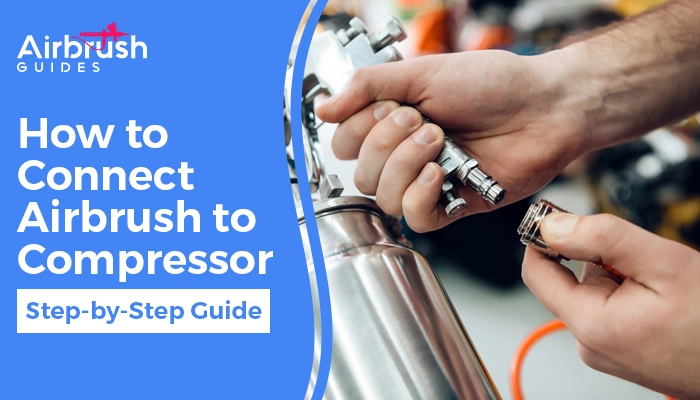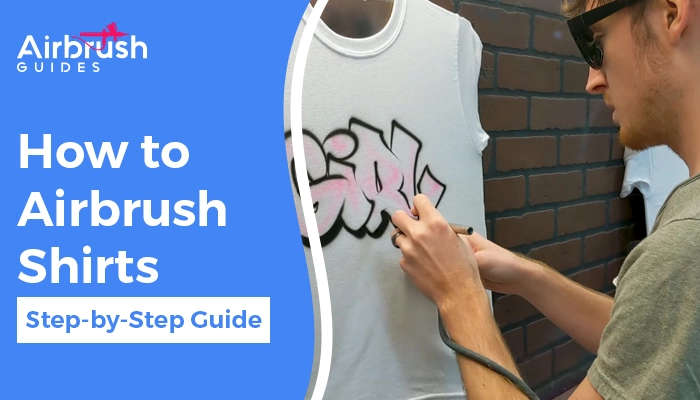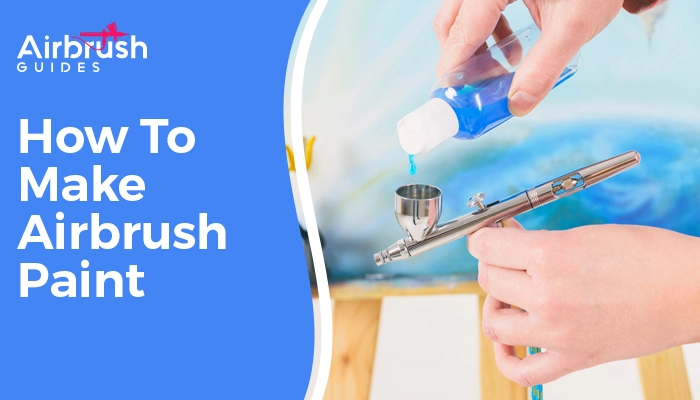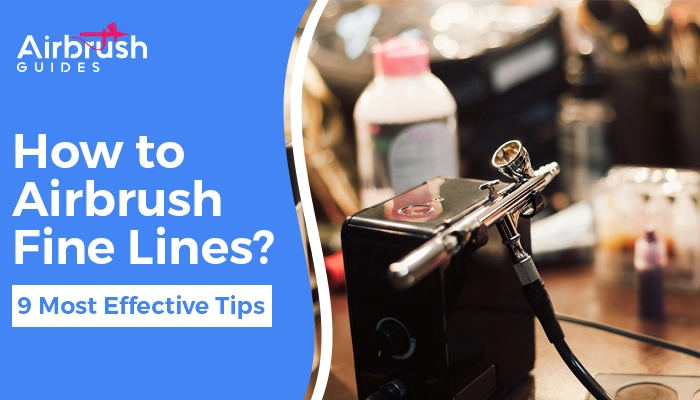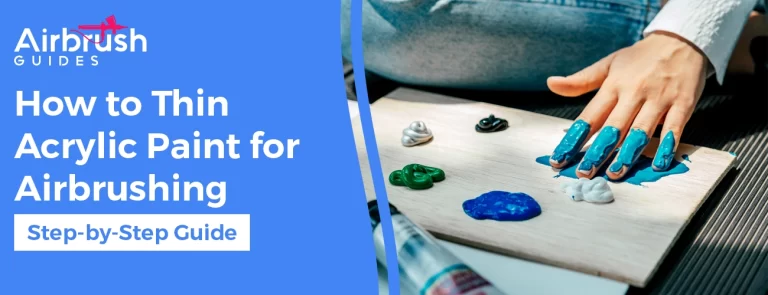How To Use Airbrush The Right Way – Step by Step Guide
I love to use an airbrush. It has multitasker nozzles that can convert your imaginable art into tangible painting. The Airbrush technique is interesting, unique, and charming in its application on almost every surface, from tiny objects to vast areas. Now I will share a guide according to my experience with you on how to use airbrush.
Before going deep into knowing about the functionality of an airbrush, it is better to know the necessary tools used in this technique. Those mandatory items are described below:
Supplies Needed – Pre Action Plans
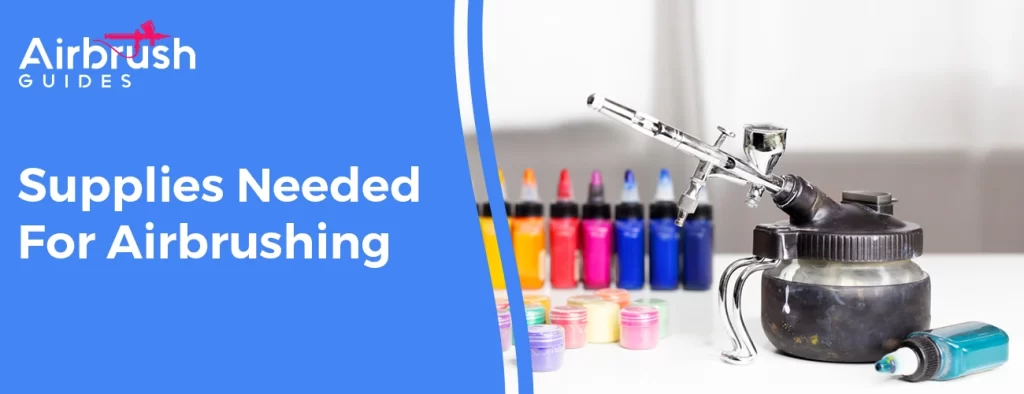
Tools and Equipment are compulsory to perform any task efficiently. If you want to get marvelous results from the airbrush technique, you need the required items. Those kinds of basic parts are given below:
- The Airbrush Gun
An airbrush gun is one the most important tool in this technique. It is used to spray the paint. The distinct feature of the airbrush gun is that its working principle is the same but has different operational features. Based on handling, it is further divided into two types.
- Single Action
Single-action airbrush guns are useful for beginners. It has different control for pressure and paints flow. Its trigger controls the air volume, and the knob regulates the flow of paint. It is easy for simple painting and joint art projects. But a single-action gun is not suitable for artistic work.
- Double Action
This type of gun is perfect for professional artists. It requires regular practice to use effectively. It has a single button to regularize air pressure and paint flow. In double-action, the Airbrush, when the button is pressed down, allows the air to release. In the same way, drawing back the button releases paint. It produces a customized pattern of spray-on any object. It has much better control than a single-action airbrush gun.
- Airbrush Compressor
An Airbrush compressor is usually used to generate a fine and continuous steam mist with constant pressure. It atomizes and pushes the paint with continuous pressure. Thus, making the finished painted surface super clean.
Normally, 1.5 to 2.5 bar pressure is suitable for airbrush guns. In addition, I recommend the airbrush compressor, equipped with a built-in air tank, water separator, and pressure regulator. This Equipment will not only bring improvement in airbrushing but make your work smooth and uninterrupted.
- Airbrush Hose
An Air hose is used to link the Compressor and Airbrush. A compact and firm connection are necessary for perfect functioning. There are different models of airbrushes available; before picking, any model, make sure that you have chosen one which has compatibility with your Airbrush.
- Airbrush Paints
Paint plays a vital role in an airbrush. There are wide ranges of paint available in the market. The choice of paint depends on its usability.
Airbrush paints comprise acrylic paint, lacquer paint, textile paint, matt color, and food color, but the choice depends on the projects you intend to start.
Generally, there are two types of paints for airbrushing, Water paint and lacquer paint .but the Quality of any paint depends on its pigmentation.
Lacquer-based paint is not fit for health. It requires special safety measures, and the airbrush painter must wear a respirator or mask. Furthermore, it needs special cleaning agents to clean the airbrush gun.
On the other hand, water-based paints are safe for health, very common, and easy to use for beginners.
- Air Tank
The Airbrush tank brings continuity to work and completes it in less time. It ensures the constant pressure to smooth painting work. The Airbrush compressor with the air tank keeps the required pressure inside the tank for a certain limit during painting.
When the pressure drops from its optimum level, the Compressor starts working without the annoying noise. So, an artist feels relaxed and focused during his working hours.
- Pressure Gauge/Regulator
Constant pressure produces fine spraying patterns, and interrupted pressure creates fuzzy ones. So, a pressure regulator is a piece of important equipment to make the pressure continuous.
The pressure gauge is an indicator that measures the amount of air volume in the air tank. Its unit is represented in Barr. Normally the pressure for airbrushing is kept between 1.5 and 2.5 Barr. Precise adjustability of pressure is a necessary factor for a nice spraying pattern.
- Water Separator
The water separator is packed with an airbrush compressor. It is used to collect water during compression. It stops the outflow of water in compressed air to make the spraying pattern charming and real.
It is a matter of common observation that during compression, the ability of air to hold water molecules is lost due to high pressure. This phenomenon is common in typical compressors. If few water droplets are expelled from the air stream, it can distort the paint visibility, and paint blobs may appear on the artwork.
- Masking Tape
While painting some surfaces is closed enough, there is a chance of overlapping over those areas, and the final outlook of the painted object is not eye-catching. To avoid such overlapping, a masking tape is a useful option.
- Latex Gloves
Latex gloves are also an important element while painting. It acts as a protective shield that keeps your skin healthy and natural. Excessive work of airbrushing can make your skin dry and dull.
- Cleaning Kit
A cleaning kit is an essential Equipment for airbrushing. The kit includes different kinds of brushes, cleaner solutions, and cleaning pots. If you want to enhance the lifetime of an airbrush, the cleaning kit is a basic requirement.
Normally Paints have an adhesive property that clogs the air gun. Due to clogging, paint flow is disrupted, and unintentional patterns of color may appear on the painting surface. So, the air gun must be clean and unclogged after the first color change. Also, the user must have a cotton swab or tissue paper while airbrushing to clean the air gun repeatedly.
How To Use An Airbrush?

It requires complete technical expertise to use an airbrush. Extensive practice on cheap objects is a prerequisite before professional usage of airbrushes. Without proper experience and skill, you cannot produce attractive, heart-felt color shades.
Below is the step by step guide about how to use an airbrush.
- Connect Air Hose
- Preparation of Airbrush Paint
- Pour the Paint Into The Airbrush Cup
- Turn On The Compressor
- Start painting
- Connect Air Hose
A firm and perfect hose connection with the air compressor is necessary for constant airflow. So, make sure to connect the connection of the air hose first.
- Preparation of Airbrush Paint
Now prepare the paint for your objects. At this stage, thin your paint in any pot because all the paints have sticky materials that can clog your air gun. The thinning ratio depends upon the surface but is commonly printed on paint packaging.
Casually water is used as a thinning agent to thin acrylic paint. For lacquer paint, lacquer thinner is available in the market. Similarly, for enamel paint, paint thinner is used.
- Pour The Paint Into The Airbrush Cup
Pour the prepared paint into the airbrush cup. Initially, put a few drops of paint to check
for any cup leakage. If no leakage is found, pour the rest of the paint into the cup.
- Turn On Compressor
Now turn the Compressor on to generate optimized pressure for airbrushing. Usually, pressure is kept between the range of 1.5bar and 2.5bar.
High pressure produces tiny paint droplets which dry quickly. Another benefit of high pressure is less clog formation, which can smooth your paintwork. However, there is a chance of over-spraying, which can be overlooked.
In the same way, low pressure throws less paint, which may cause clogging in the air gun. Due to low pressure, paint texture may look stained and rough.
How to Hold An Airbrush?
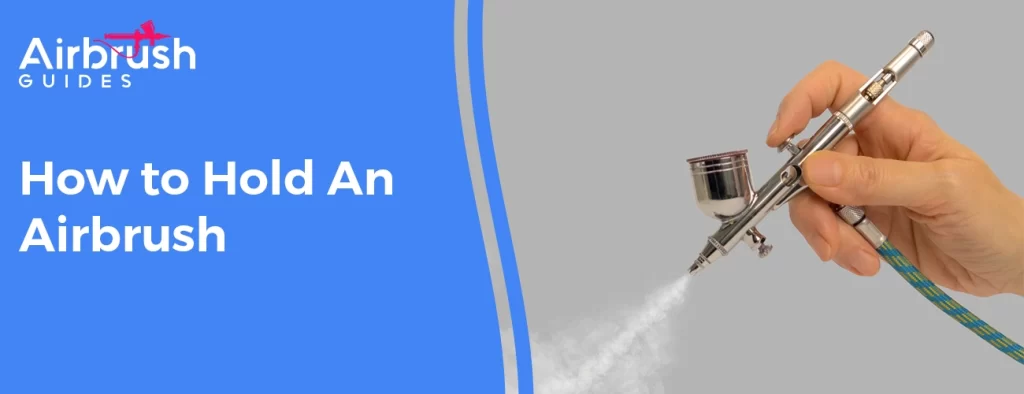
If you are a newbie in airbrushing, you may find it difficult to hold an airbrush. Practice makes you a perfect airbrush artist. So, firstly test painting on a simple printer page. Start airbrushing to analyze different spraying patterns and behaviors like consistency, shades, and coloring effects.
A smart hold on an airbrush makes your color shades natural, attractive, and realistic. So, hold your Airbrush like a pen. Place your index finger on the top of the trigger. An important factor to remember is never to hold the Airbrush tightly. Retain the Airbrush 1-2 inches farther from the object. The thickness of lines and pattern of shades depend on the gap between the object and Airbrush.
Now push the trigger down to allow airflow and pull it back to allow the paint flow. But you have to perform both functions simultaneously.
How Far Away You Should Hold the Airbrush
Distance between object and Airbrush decides the final outlook of your object. It requires continuous practice so that a correct estimation of distance must be framed in your mind.
If you move the Airbrush away from the surface, a large area can be covered, but the spraying pattern would be undefined, vague, and defused. On the contrary, a small but more obvious, fine, and well-defined pattern would appear as you bring the air gun closer to the surface.
How to Clean an Airbrush?
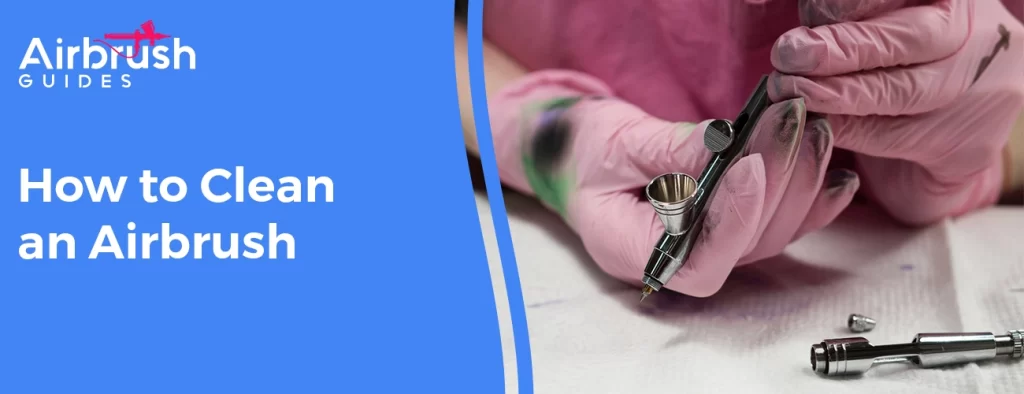
Cleaning the Airbrush is a tricky and careful task. The performance of airbrushes heavily depends on the proper cleaning of Equipment. Paints have sticky materials that can clog the nozzles. Here are some tips for cleaning an airbrush
- clean the Airbrush after the application of each color before using another color
- purchase airbrush cleaning solution from any paint store and clean the cup of Airbrush with that solution.
- If there exist stubborn stains like cake fat and residue of lacquer paint, firstly scratch those parts and clean them with the soaked cotton swab.
- Now put your finger on the nozzle and apply backward pressure on the Cleaning solution of the airbrush cup. At this point, ensure that your Airbrush is well connected to the Compressor.
- Continue this practice until the color of the solution becomes transparent.
Application of Airbrushing
Airbrushing technique is extremely versatile and unique in its application. That decorates a surface with magical color shades. Here is a range of some stimulating and interesting applications of an airbrush.
- Beautification of Any Surface
Airbrush is a reasonable option for any surface that can absorb the liquid. You can enhance the look of any surface through airbrushing.
- Embellish Your Ornament
Airbrush is not only limited to a specific surface but universal in its application. Now you can give an artistic look to your ornaments and decorative beads with colorful finishing touches.
- Customize Your Shirts And Other Clothing Items
Airbrushing allows you to design your apparel, shirts, and canvas with customized colors and designs.
- Models And Statues
Gone are the days when you have to search and hire professionals to renovate your statues. Now you can do all this on your own by applying airbrushing technique.
- Make-up of Body
Airbrushing has been revolutionized enough that it is being used in the cosmetic industry. To make temporary tattoos on your body, many non-hazardous and skin-friendly paints are available for face painting and body art. You use the airbrush of spray tanning as well.
- Food Industry
Food art is an emerging and trending industry in which airbrushing is also contributing its role. You can make fancy color shades and various design patterns on cakes, biscuits, and pastries.
- Automotive Parts Decoration
Airbrushing is also used for painting cars, motorbikes, and other automotive parts. It is commonly used to conceal the scratches on cars, motorbikes, and automobiles. Using different stencils, you can customize your design with your favorite coloring scheme.
Here is video tutorial for beginners.
Frequently Asked Questions
- What is an airbrush?
An airbrush is an air-operated tool that creates tiny droplets of paint. It produces a fine spraying pattern through Compressor. It is handheld, easy to operate, and held like a pen.
- Why is airbrushing so popular?
Airbrushing is so popular because it is versatile in its operation and can be used domestically, industrially, in food art, and other fields of life. With the help of airbrushing technique, you can produce different color patterns and transitions in shades. Airbrushing helps you create imaginable art and interesting and unique effects in your painting.
- How does an airbrush work?
Airbrush working depends on compressed air. There is a trigger on the airgun, which normally performs double functions to expel air and continue the flow of paint. When the trigger is pushed down, the pressurized air will come out. Similarly, a controlled amount of paint flows out when it is pulled back.
- What type of Airbrush is best for me?
Airbrushes are mainly of two types. One is a single action, and the other is a double-action airbrush.
When you press the trigger in a single-action airbrush, it stimulates the flow of paint and air independently. Single action airbrush is commonly suggested for beginners.
On the other hand, a double-action airbrush simultaneously controls paint and airflow. When you press the trigger down, it allows the pressurized airflow. Pulling back the trigger makes the flow of paint into the air stream.
- What type of surface can be sprayed?
All absorbent and non-absorbent surfaces can be sprayed with an airbrush. But for non-absorbent surfaces, a specific kind of paint is used that can be asked from the paint manufacturer.
- What type of paints can be airbrushed?
There is no restriction on the choice of paint. For airbrushing, you can use any paint. It can be acrylics, watercolor, food color, enamel paint, and automotive. More sticky and adhesive paints can be thinned by mixing thinner in the paint.
- How to clean Airbrush?
Cleaning is an essential part of Airbrush, especially between color changes. Cleaning solutions and brushes are normally available for cleaning purposes.
Conclusion
To summarize the discussion, airbrushing is a versatile, unique, and charming shades transition technique. I explained in detail how to use an airbrush and its application in our daily life.
If you are still in doubt about which Airbrush is result-oriented and right for you, you can visit our page and explore reviews about the best Airbrush.


